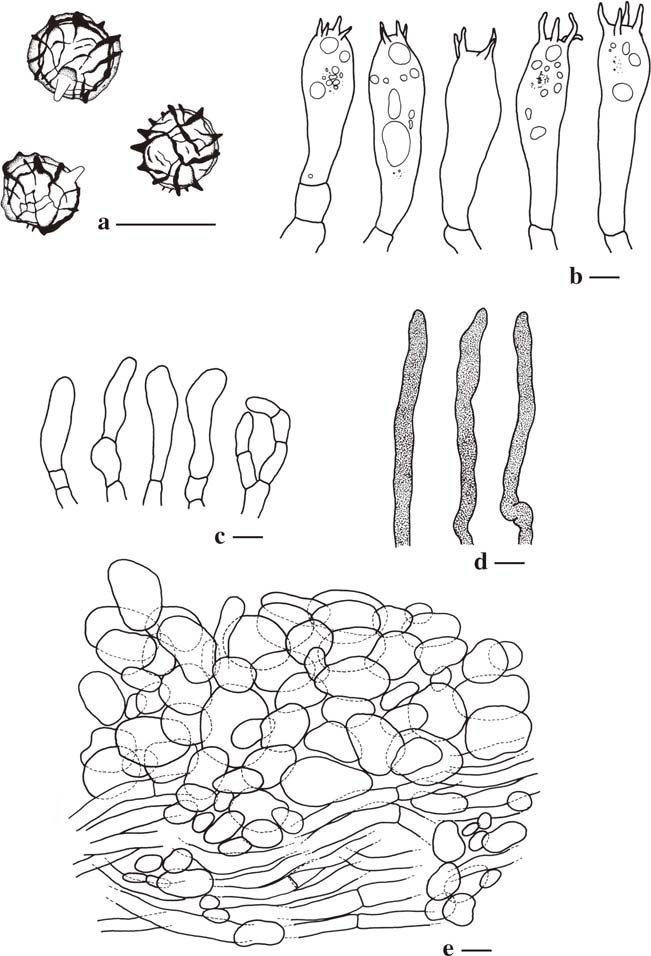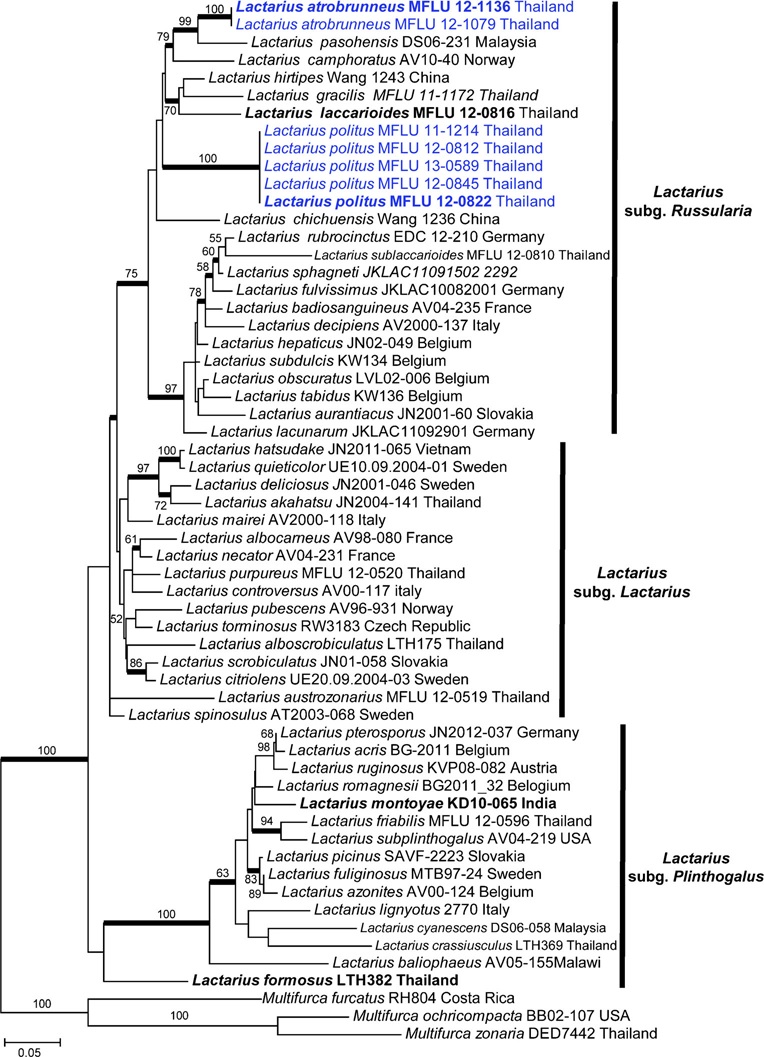Lactarius atrobrunneus Wisitrassameewong & K. D. Hyde
Index Fungorum number: IF551005 Facesoffungi number: FoF 00483
Etymology: atrobrunneus refers to dark brown colour.
Holotypus: MFLU 12–1136 Basidiocarps small sized. Pileus 6–31 mm diam., broadly convex in young specimens, with or without a small papilla, becoming plane to infundibuliform at maturity; surface dry, radially rugulose, particularly in inner half of pileus, strongly and irregularly wrinkled in the outer half of pileus, with grooves that show the lamellae in t ransparency;marginstriate, occasionally fissured, incurved; surface blackish to dark brown when young, turning less unicolourous and between dark brown (9 F8), reddish-brown (9E8) and blackish when older. Lamellae subdecurrent to decurrent, 1–2 mm broad, distant, with 1–2 series of lamellulae, beige to greyish beige (4C2–4C3) to fuliginous. Stipe 14–37×1–4 mm, fragile, cylindrical, more or less concolourous to pileus, with darker brown tints when old. Context thin-fleshed, 0.5–1 mm broad in pileus, pinkish to clay buff, darker in cortex, unchanging when cut, but changing yellow with 10 % KOH within seconds; smell like L. quietus, like Pentatomidae bugs; taste mild. Latex rather abundant, pure watery, unchanging when exposure, unchanging with 10%KOH, unchanging on white tissue or paper; taste faintly bitter. Basidiospores subglobose to ellipsoid; 6.9–8.1–8.2–9.6 (−10.7)×6–7–7.2–8.3(−8.5) μm, Q=1.06–1.15–1.16–1.29 (n=40); ornamentation amyloid, subreticulate, composed of ridges up to 1.5μm high; ridges often spiny and irregular, rather broad, interconnected by finer lines, forming an incomplete to subcomplete reticulum; isolated warts infrequent; plage distally amyloid. Basidia 55–72×18–20μm, mostly 4–spored, with small or large guttulate contents. Pleuromacrocystidia absent. Pseudocystidia 4–6μm diam., cylindrical, often curved, slightly emergent to emergent. Lamellae edge heterogeneous, with some basidia present; marginal cells 11–44×5–12μm, subcylindrical to subclavate; cheilocystidia absent. Lamellar trama mixed, composed of small and large globose cells, septate hyphae and lactiferous hyphae. Pileipellis an epithelium, about 40–70μm thick, composed of globose cells of 5–25μm diam., with some subclavate elements on top; underlying layer composed of smaller globose cells and cylindrical hyphae.
Habitat: gregarious on naked soil, in montane tropical forest with Fagaceae trees.
Material examined: THAILAND, Chiang Mai Province, Mae Taeng District, Pa Pae sub-district, Mushroom Research Centre, N19°17.12 E98°44.00, elev. ca 900 msl., KW347, 9 July 2012 (MFLU12–1136, holotype, isotype in GENT. GenBank ITS: KP744442); ibid., KW270, 7 June 2012 (MFLU12–1079, paratypes; isoparatypes in GENT GenBank ITS: KP744443).
Notes: Lactarius atrobrunneus is rather unique and well recognizable in the subgenus by its small size and striking blackish-brown colour. Furthermore the strongly rugose cap, the pure transparent latex and distant gills are striking field characters. Microscopically, the rather spiny and heavy spore ornamentation and the well-developed epithelium as a pileipellis structure are striking. Other species of the subgenus with remarkably distant lamellae are L. laccarioides Wisitrassameewong & Verbeken, L. sublaccarioides Wisitrassameewong & Verbeken , L . stubbei Wisitrassameewong & Verbeken and L. pasohensis Wisitrassameewong & Stubbei (Wisitrassameewong et al. 2014). All of themare larger and have distinctly orange brown colours and white latex.

Lactarius atrobrunneus (holotype) a Basidiospore b Basidia c Marginal cells d Pseudocystidia e pileipellis. Scale bar=10μm. Drawings by K. Wisitrassameewong

Phylogram generated from Maximum likelihood (RAxML) analysis based on ITS sequence data. Maximum likelihood bootstrap support values greater than 50 % are indicated above or below the nodes, new species are in blue and species for which obtained sequences are based on type material have names in bold .The tree is rooted with Multifurca furcatus RH804, Multifurca ochricompacta BB02 107 and Multifurca zonaria DED7442
Read more: http://link.springer.com/article/10.1007/s13225-015-0324-y

